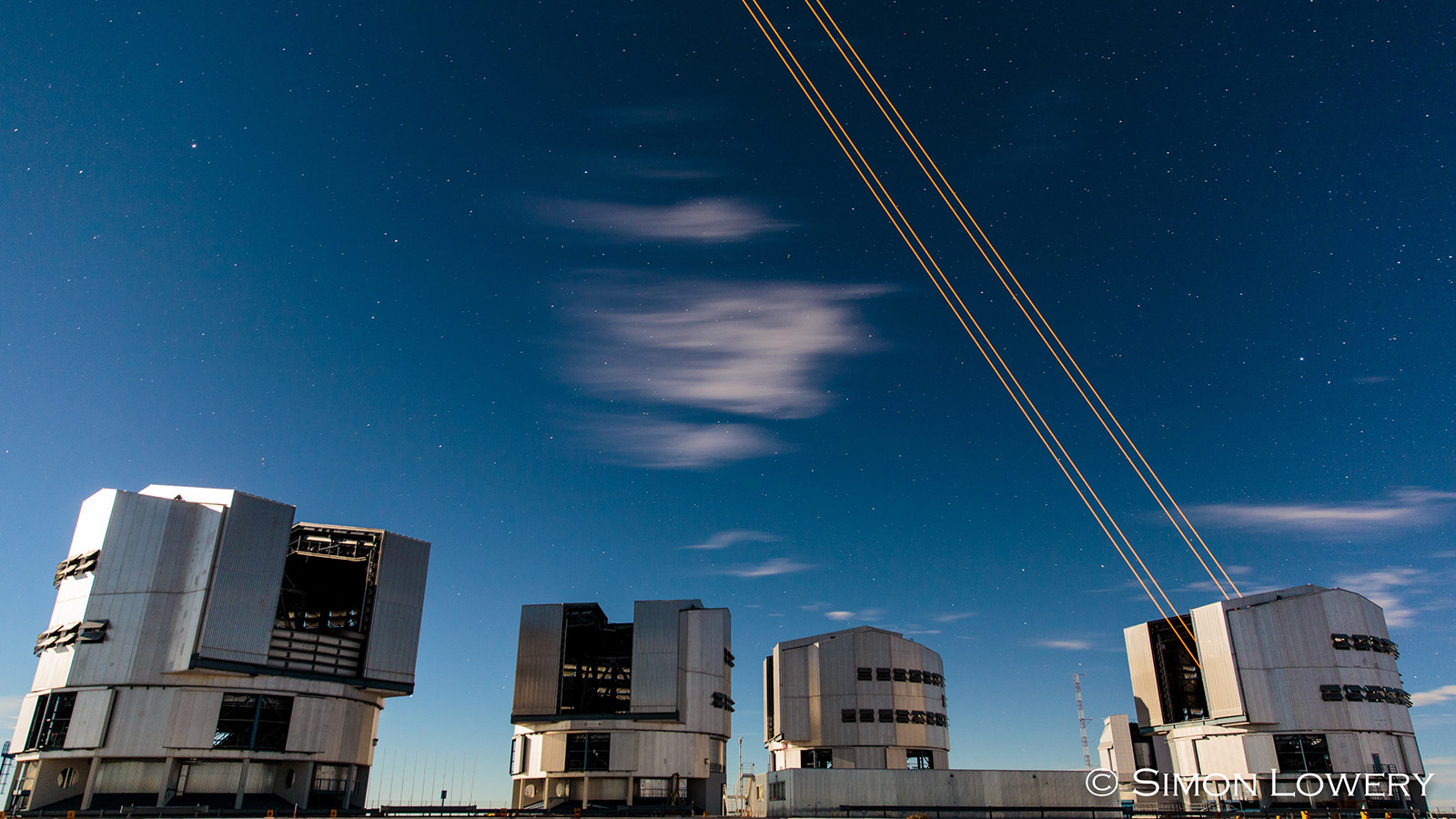HOME
Orion Nebula and the 4 Laser Guide Stars
ESO Paranal Observatory, Chile
© Stéphane Guisard, Los Cielos de América
The images in this page were taken at the
ESO Paranal Observatory located in the Atacama desert in the North of Chile.
Professional astronomers use powerful Lasers to create bright artificial stars in the sky in the direction of their observations. These Laser stars are used as "reference points" to measure and correct in nearly real time (a measurement and its associated correction do not last more than a few milliseconds) the deformation of the light path due to atmospheric turbulence. This correction is done by a deformable mirror in the optical path of the telescope. All these methods and associated technology is called "Adaptive Optics.".
About the Laser technology: The laser used is a "Sodium Laser". It is used to "excite" Sodium atoms in the so-called "Sodium layer", a layer located in the very high atmosphere at about 80 to 90 Km from the ground. After being excited by the Laser, these Sodium atoms come back to their initial state and emit light of the same orange color as the Laser. Seen from Earth, this re-emited light is seen exactly as if it were a light source located at 80-90 Km altitude. In order to be even more precise in the measurements and corrections of the atmospheric turbulence, the astronomers can use several laser around the object they want to observe. Paranal observatory recently got equiped with 4 of these lasers.




Orion Nebula (Messier 42) and the 4 Laser Guide stars :
During technical tests of the 4 newly installed Laser at Paranal Observatory, UT4 and its Lasers were pointed towards M42, the Orion Nebula. An amateur telescope installed next to UT4 dome was used to take the image below. It shows the 4 laser lines from UT4 pointed at the Orion nebula. These lines are visible because part of their powerful light is diffused by molecules, humidity or dust of the lower atmosphere. These lines are visible up to a few kilometres of altitude on this image, we can actually see them faint out progressively while they propagate up in the atmosphere. In the direction of these lines we can then observe 4 small "light segments". They are the actual "Laser Guide Stars" located at around 80-90Km altitude and which emit their light towards us. The nature of the light seen on the Laser lines (light diffusion) is therefore different from the one of the Laser Stars (Light emission). If we were looking at the Laser stars from the line of sight of UT4, the telescope that launched the laser light, we would see them as 4 small light spots. But since we took this picture with a small telescope located outside UT4 dome, off-axis from the Laser lines, we see in fact the Laser stars in perspective as small light segments. The tips of these small segments delimites the boundaries of the Sodium layer.
About this image : This image was taken with a 50cm diameter telescope and a Sbig STL-11000 Camera through LRVB filters. Only one image of 10 seconds was taken for each filter ! The reason for the small exposure time chosen was to limit the apparent field rotation of the laser in the sky during the exposure (and during the long reading and downloading time of the CCD, about 30 sec), because the orange light of the laser is visible partly through the red filter and partly through the green filter. If too much time had passed between the red and the green images, the laser would not have appeared as one orange line but as a red line next to a green line. This effect is slightly visible on the image : one side of the laser lines has a redish border while the other one has a greenish border.

General view of Paranal Observatory. The four domes contain one 8m diameter telescope each, named UT1 to UT4 from left to right on this image. 4 lasers launched from UT4 are visible as coming out of the dome at night, the moonligh lit the sky and foreground on this image. This beautiful picture was taken by my friend Simon Lowery (Image used with permission).

This schematic view shows how the Four Laser Guide Star Facility is installed on the Unit Telescope 4 of ESOs Very Large Telescope. The different components are labelled. Credit (text and image) : ESO/L. Calçada
